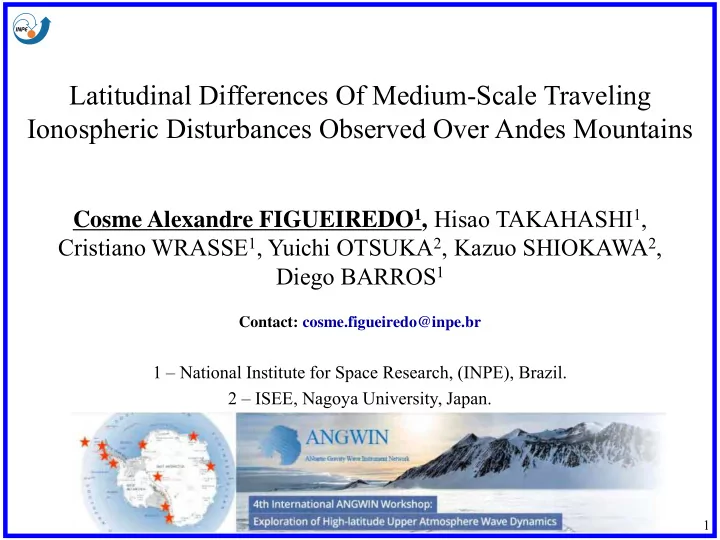

Latitudinal Differences Of Medium-Scale Traveling Ionospheric Disturbances Observed Over Andes Mountains Cosme Alexandre FIGUEIREDO 1 , Hisao TAKAHASHI 1 , Cristiano WRASSE 1 , Yuichi OTSUKA 2 , Kazuo SHIOKAWA 2 , Diego BARROS 1 Contact: cosme.figueiredo@inpe.br 1 – National Institute for Space Research, (INPE), Brazil. 2 – ISEE, Nagoya University, Japan. 1
Outline 1. What are traveling ionospheric disturbances? 2. How to calculate the detrended total electronic content (dTEC)? 3. Observation methodology and dTEC keogram analysis 4. Results of MSTID in different latitudes over Andes 5. Summary 2
What are Traveling Ionospheric Disturbances? Traveling ionospheric disturbances (TIDs) are wave-like perturbations that occur in ionospheric plasma, with wavelengths in the range of hundreds to thousands of kilometers and phase velocities of the order of hundreds of meters per second (HUNSUCKER, 1982; KELLEY, 2011). MacDou gall et Paulino al. et al. (2011) (2016) Otsuka et al. (2013) 3
Methodology Total Electron Content satellite TEC N ds e recevier TECU = 10 16 electrons/m 2 4
Methodology Detrended TEC (dTEC) After calculate the TEC, we calculate the perturbation components of TEC (dTEC) from TEC(t) subtracting the TEC trend obtained from a 1 hr. running average for each couple of a ground receiver and GNSS satellite. dTEC t TEC t TEC t 30 min . ~40 receivers CAP ANDES (NICT Server) LISN 5
GPS ground based receiver Area of observation 6
MSTIDs over Andes Night Dusk Solar Terminator Dawn Solar Terminator What is the better way to observe MSTIDs? 7
Keograms Keogram is made by taking latitudinal and longitudinal cut section of each processed dTEC map image, and, then, taking them to make a time series (time resolution of 1 min) 8
Criteria used to identify MSTIDs Established by Kotake et al. (2007), Otsuka et al. (2011, 2013), and Figueiredo et al. (2018) 1. The amplitude of oscillation of dTEC is exceeding 0.2 TECU; 2. The horizontal wavelength is shorter than 1,500 km; 3. The period is less than ~60 min; 4. The oscillation has more than two wavefronts and propagates on the maps or keograms; we assume that the propagation direction is perpendicular to the wavefront of MSTIDs; 5. We have selected wavefront greater than 3° in latitude and longitude in the keograms. 9
Keograms Analysis Methodology How to extract MSTIDs parameters? 10
Keograms Analysis Methodology Analysis of MSTIDs using 1D-FFT cross-spectrum 11
Results: Low/middle latitude Low Latitude (10-30°) Middle Latitude (30-50°) Observation period: Observation period: January/2013 January/2013 MSTIDs Events: 6 MSTIDs Events: 48 Time occurrence: 18:00 – Time occurrence: All Day 23:00 UT 12
Results: Parameters in Low/middle latitudes Middle Latitude Low Latitude 13
Results: Propagation Direction Southeast- Southwest Daytime Low Latitudes Northwest Daytime Nighttime North, Northeast, and Southeast Middle Latitudes 14
Discussions Low Latitude : Time and occurrence rate Southeast – South of Brazil (826 MSTIDs) Similar results Figueiredo et al. (2018) 15
Discussions Low Latitude: Propagation Cloud top Temperature direction Andes Southeast – South of Brazil Figueiredo et al. (2018) Is it generated by deep convection in the amazon region or secondary waves or in situ ? 16
Discussions Middle latitude: Occurrence Nighttime MSTIDs in El Leocinto – Argentina Martinis et al. (2010) We do not find any paper about daytime MSTIDs over the Andes. 17
Discussions Middle latitude: Propagation direction Daytime MSTIDs sources Nighttime Orography ??? Cold front??? Well Known Perkins Stability 18
Summary 1. A total of 54 MSTIDs were observed in different latitudes. 2. Low Latitude MSTIDs are similar with Figueiredo et al. (2018) results. 3. Nighttime MSTIDs are generated by Perkins stability and daytime MSTIDs need more studies. 4. Why the MSTIDs originated in middle latitudes do not propagate to low latitudes? 5. why nighttime MSTIDs were not observed at low latitudes? 19
Acknowledgments Thank you very much!!! Muito Obrigado!!! Contact: cosme.figueiredo@inpe.br 20
Bibliography PAULINO, I.; MEDEIROS, A. F.; VADAS, S. L.; WRASSE, C. M.; TAKAHASHI, H.; BURITI, R. A.; LEITE, D.; FILGUEIRA, S.; BAGESTON, J. V.; SOBRAL, J. H. A.; GOBBI, D. Periodic waves in the lower thermosphere observed by oi630 nm airglow images. Annales Geophysicae, v. 34, n. 2, p. 293 – 301, 2016. FIGUEIREDO, C. A. O. B.; TAKAHASHI, H.; WRASSE, C. M.; OTSUKA, Y.; SHIOKAWA, K.; BARROS, D., Medium ‐ scale traveling ionospheric disturbances observed by detrended total electron content maps over Brazil, Journal of Geophysical Research, 123, 2215 – 2227, 2018. MARTINIS, C.; BAUMGARDNER, J.; WROTEN, J.; MENDILLO, M. Seasonal dependence of mstids obtained from 630.0 nm airglow imaging at arecibo. Geophysical Research Letters, v. 37, n. 11, p. n/a – n/a, 2010. ISSN 1944-8007.L11103. MacDougall, J., M. A. Abdu, I. Batista, R. Buriti, A. F. Medeiros, P. T. Jayachandran, and G. Borba (2011), Spaced transmitter measurements of medium scale traveling ionospheric disturbances near the equator, Geophys. Res. Lett. , 38, L16806, doi: 10.1029/2011GL048598. OTSUKA, Y.; SUZUKI, K.; NAKAGAWA, S.; NISHIOKA, M.; SHIOKAWA, K.; TSUGAWA, T. GNSS observations of medium-scale traveling ionospheric disturbances over Europe, Ann. Geophysicae, Volume 31, Issue 2, 2013, pp.163-172, doi: 10.5194/angeo-31-163-2013, 2013. 21
Recommend
More recommend